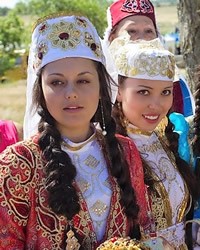Throughout history, Armenia has been a battlefield for many invaders and contending empires and a bridge for many cultures and civilizations. During the past 2,700 years, Armenia has been conquered by the Persian Empire, Alexander the Great, the Roman Empire, the Byzantines, Arabs, Mongols, Tatars, Ottomans, Persians and Russians. Armenian kingdoms, principalities, and even a short-lived empire (95-55 B.C.) survived and thrived for some 1,700 years. Under various kings and princes, the Armenians developed a sophisticated culture, original architecture, and their own alphabet.
The 1905 Russian Revolution and the 1908 Young Turk Revolution raised the hopes of the Armenians for reform and an opportunity to build a homeland in historical Armenia. These hopes were dashed as the Ottoman and the Russian Empires fought each other during World War I. A dark hour of Armenian history is the Armenian genocide, which started on April 24, 1915. Some 1,750,000 Armenians were deported into Syria and Mesopotamia by the Ottoman authorities. Subject to famine, disease, and systematic massacres, most of them perished. This "ethnic cleansing" of the Armenians from their historical homeland led Raphael Lemkin, the father of the Genocide Treaty, to coin the new term "genocide" in the 1930s to describe the historical plight of the Assyrians and the Armenians as subjects of the first genocide of the 20th century.
A large percentage of Armenian refugees and survivors of the Ottoman Empire s massacres resulted in them fleeing to parts of the Arab world. That situation increased the numbers of Armenians in Egypt, Syria, Iraq, Sudan and Ethiopia.
Many of the Armenian survivors of the massacres and genocide settled in modern Syria, mainly in Aleppo. The new arrivals were aided by Armenian and American missionary and philanthropic organizations and succeeded in invigorating the earlier settlements and creating one of the most active Armenian communities in the twentieth century. In many ways the Armenian schools, churches, centers, and hospitals in Syria became the inspiration and model for the Armenian communities of Beirut, Baghdad, Jerusalem and Amman during the second half of the twentieth century.
Armenians remain in Syria, but some have been leaving ever since the civil war began in 2011. With a new Turkish-friendly government in 2024, there is a good chance many will flee to Armenia in the years to come.
During the civil war, Armenians tried to continue with their shops and restaurants. Those with restaurants have learned to combine the tastes of Armenian and Syrian-style foods.
In 301 AD, during the rule of King Dirtad III, Armenia became the world's first Christian nation. A Christian monk, commonly known as Krikor Lusavorich or St. Gregory the Illuminator, cured the king of a disease. After this event, King Dirtad III was baptized and accepted Christianity as Armenia's official state religion. Before this, two disciples had brought Christianity to Armenia, St. Thaddeus and St. Bartholomew. Today, Armenia is still a Christian nation, comprising of Armenian Apostolic Orthodox (the majority) and other Christians (a small percentage).
The traumatizing experience of being expelled from their homeland and the historic genocide made a deep impression on Armenians. Many have trouble forgiving the Turks after over 100 years. This impedes their spiritual lives. Those in Syria also have to deal with the trauma of a recent war.
Pray for healing for Armenians and for the ability to integrate into their respective diaspora communities.
Pray for the Armenians in the diaspora to hold on to their Christian faith and to have a personal experience with Jesus Christ.
Pray for peace; this is what Armenia needs most of all.
Pray that God would bring revelation of Christianity as a spiritual relationship rather than a call to nationalism.
Scripture Prayers for the Armenian in Syria.
https://en.wikipedia.org/wiki/Armenians_in_Syria
https://agbu.org/leaving-syria/armenians-syria
https://www.bing.com/videos/riverview/relatedvideo?q=armenians+in+syria&mid=6A9EBA7F436BB7AA349D6A9EBA7F436BB7AA349D&FORM=VIRE
https://www.youtu
| Profile Source: Joshua Project |












